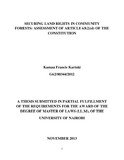| dc.description.abstract | Forests provide environmental, socio-cultural and economic benefits to mankind. They are particularly important to forest dwellers and hunter-gatherers as they derive their livelihoods from there and consider them as their ancestral lands. Section 3 of the Forests Act 2005 defines forest communities as groups of persons who have a traditional association with a forest for purposes of livelihood, culture or religion or who have been registered as an association or other organisation in forest conservation. Access to forests by these communities has, however, been restricted by government policies inherited from the colonial powers, which were largely preservationist. Moreover, competing land uses over forest lands for human settlement, farming, industrial development, livelihood support for the forest dwellers, as carbon sinks and water catchment areas, is a major source of conflicts. This has impacted negatively on forest communities who traditionally had rights of access and control of forests which existed even if land belonged to a different legal entity. There have been efforts by government towards recognizing the rights of forest communities in Kenya.
These efforts culminated in the adoption of the Constitution of Kenya 2010 which in Article 61(2), recognizes community land. Community land is defined in Article 63(2)(d) to include land lawfully held, managed or used by specific communities as community forests, grazing areas or shrines; ancestral lands and lands traditionally occupied by hunter-gatherer communities or lawfully held as trust land by the county governments. This is an important development in securing the land rights of forest communities and access to forest and forest products. By reviewing relevant literature, laws and policies, this study sought to examine the treatment that such lands have received under formal laws in Kenya and the implications of protecting community land for forest communities in the Constitution 2010. It also sought to
come up with proposals and recommendations on how to improve the laws to ensure adequate protection of the land rights of forest communities in Kenya. This is important because the multiple uses to which forests can be put into present a challenge in coming up with an appropriate tenure arrangement that secures competing interests, including those of forest communities. The methodological approach adopted in this study was a review of relevant literature on land and forests in Kenya. The qualitative data gathered was critically analyzed and evaluated in the context of the research objectives. | en |


